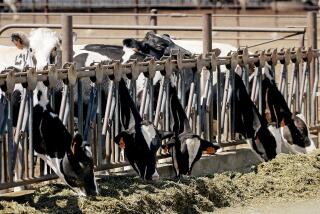Happy Cows Equal Milk Glut
- Share via
It’s easy to forget these days that milk comes not from pasteboard cartons but from cows--real cows that eat real grass and go through real mood swings, just like the rest of us.
Traditionally, there is less milk in the fall and winter than in the spring and summer. The reason is simple. In the spring and summer, the grass is fresh, the sun is shining and the cows can get outside for a little exercise. In the winter, they’re cooped up in a stuffy old barn eating dry hay, and who the heck feels like giving milk with working conditions like that? (Dairy marketers do point out that the sole exception to this is California, where the weather’s always nice.)
This is unfortunate for milk producers because milk sales peak in the winter, when schools are in session, and decline in the summer, when the kids are, presumably, drinking lemonade. Because of the reduced supply, milk prices tend to go up in the winter and down in the summer.
This year has been a little different. Because the summer has been mild throughout the Midwest, milk production has been even higher than normal (cows don’t like to give milk when they’re hot and sweaty, either). As a result, there is more milk in the commercial pipeline than normal at this time of year, meaning prices for that milk are dropping--though, because of the complex arrangement of government price supports, the seasonal price fluctuation is kept to a minimum.
One of the ways the seasonal excess of milk has been dealt with is cheese. More than just “milk’s leap toward immortality,” cheese is a way of storing milk so that its nutrients can be used later--much the same way wine started as a way of preserving grapes.
And with so much milk in the pipeline, cheese prices are apt to stay soft as well. That’s good news for this winter, because winter is also the peak season for cheese consumption. In fact, the biggest single period of cheese eating in the United States--bigger even than the Christmas holidays--is Super Bowl Sunday. It has to do with take-out pizzas.
* With fall officially here, it’s time to switch from summer apples such as Gala and Fuji to more standard varieties such as Granny Smith and Red and Golden Delicious. But because the last several weeks have been so mild, the Galas and Fujis are hanging in with excellent quality, though they’re in shorter supply. When buying apples, it’s important to remember that the varietal name is Golden Delicious, and it’s when they reach that honeyed color that they have the best flavor. There seem to be a lot of green Delicious apples on the market lately.
IN GROWERS MARKETS Surely the most beautiful growers market in Los Angeles is on the slope just south of the Redondo Beach Pier, overlooking the ocean. On Thursday mornings, there is salmon, thresher shark, rex sole with the roe and gorgeous yellow fin tuna and halibut, all from San Pedro’s J&P; West Coast Fish. Bernard Ranches in Escondido has Valencia oranges, pink and white grapefruit and butternut squash. Triple J Farms in Westminster has yellow and white corn, purple beans, Blue Lake green beans, haricots verts , basil and garlic chives. M. B. Farms from Raisin City, near Fresno, has fresh crop pistachios and almonds and sun-dried figs. Peacock Farms has four kinds of eggplant (thin-skinned, purplish Chinese; thicker-skinned, dark Japanese; white, thick-skinned Caspar, and traditional Globe), raisins from Thompson, and Flame Seedless grapes, both sun-dried, with a caramel-y flavor, and sulfurized and dehydrated golden, with a fruitier flavor. Nichol’s Farm from Arroyo Grande has haricots verts , snow peas, Blue Lake green beans and mini-corn. Tenerelli Orchards from Littlerock has late stone fruit like Fairtime and Indian Blood (a white variety) peaches and September Red Nectarines.
More to Read
Eat your way across L.A.
Get our weekly Tasting Notes newsletter for reviews, news and more.
You may occasionally receive promotional content from the Los Angeles Times.







